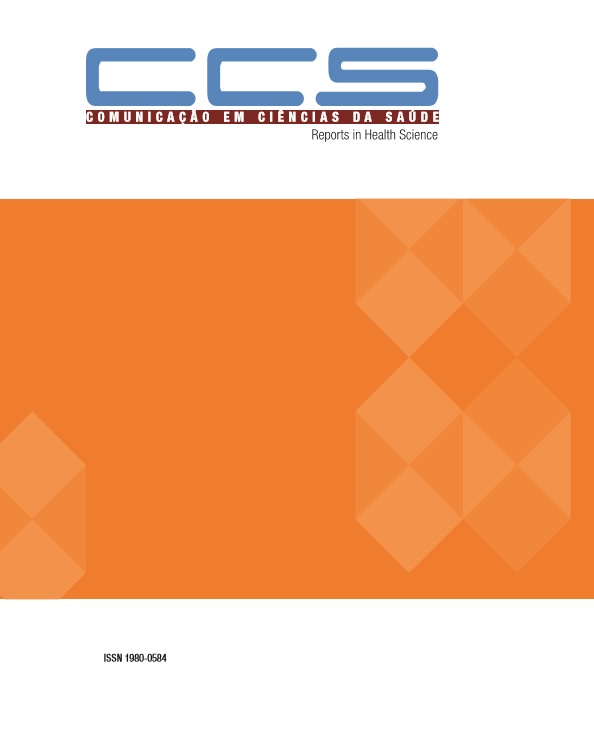NUTRITIONAL AND CLINICAL PROFILE OF OLD DIABETIC PATIENTS INSTRUMENTED IN A MEDIUM COMPLEXITY INSTITUTION OF THE PUBLIC HEALTH NETWORK OF THE FEDERAL DISTRICT
DOI:
https://doi.org/10.51723/ccs.v29i02.259Abstract
Introduction: Diabetes is characterized by a group of metabolic diseases involving hyperglycemic disease. In relation to the elderly, it can be associated with more emphasis to the complications, dysfunctions and insufficiency of several organs, compromising the life standard of the individual.
Objectives: The objective of this study was to analyze the nutritional status, as well as to draw a brief general clinical profile of type 2 diabetic elderly admitted to the medical clinic of a medium complexity public hospital located in the Federal District.
Methods: Clinical, anthropometric variables and the respective classifications available in the Mini Nutritional Assessment (MAN) were considered. Twenty-two elderly men and women with a diagnosis of type 2 DM for at least 1 year participated in the study.
Results: The number of participants in the study was higher among the female subjects (68.18%) and the mean age was 71.3 years. The percentage found for nutritional status showed that 45.45% of the participants were overweight. Regarding the causes of hospitalization, diabetes was not the main cause in any of the records. From the total of 22 elderly, 12 presented a reliable source regarding the determination of the time of diagnosis, which remained on average in 9.3 years. Regarding the length of hospital stay, the minimum period was 7 days and the maximum interval was 3 months.
Conclusion: The study showed that overweight was the most frequent among males. MAN was sensitive in assessing nutritional risk in these elderly people with diabetes. It can also be inferred that, despite not being the main cause of hospitalization, decompensated diabetes is closely related to the primary causes listed in this study, such as cardiac, renal and cerebrovascular alterations. However, more studies are needed to validate these findings, including a greater number of elderly diabetics, in different care settings for the elderly, different Brazilian populations, and through different assessment instruments.
Key words: elderly; type 2 diabetes; clinical profile; nutritional status; anthropometry.
Downloads
Downloads
Published
How to Cite
Issue
Section
License
Declaro para os devidos fins que o artigo que estou submetendo representa um trabalho original e nunca foi publicado total ou parcialmente, e que se alguma de suas partes foi publicada possuímos autorização expressa para a publicação no periódico Comunicação em Ciências da Saúde (CCS). Esse artigo não foi enviado a outro periódico e não o será enquanto estiver sendo considerada sua publicação; caso venha a ser aceito não será publicado em outro periódico; e não contém material difamatório ou ilegal sob nenhuma forma, não viola a intimidade de terceiros, nem infringe direitos protegidos.
Eu e demais autores desse trabalho certificamos por meio desta declaração que:
- Concordamos com as normas editoriais e com o processo de revisão da CCS;
- Aceitamos a responsabilidade pela conduta desse estudo e pela análise e interpretação dos dados;
- Cooperaremos, sempre que solicitado, na obtenção e fornecimento de dados sobre os quais o manuscrito está baseado, para exame dos avaliadores;
- Não estão sendo omitidos quaisquer ligações ou acordos de financiamento entre os autores e companhias ou pessoas que possam ter interesse no material abordado no artigo;
- Não estão sendo excluídos ou omitidos deste artigo autores ou instituições participantes;
- Possuímos permissão para uso de figuras e tabelas publicadas em outras fontes;
- Possuímos permissão das pessoas e instituições citadas nos agradecimentos;
- O autor correspondente autoriza a publicação do endereço informado e e-mail do(s) autor(es) junto com o artigo;
- Assumimos a responsabilidade pela entrega de documentos verídicos;
- Autorizamos a publicação do referido artigo no periódico Comunicação em Ciências da Saúde, segundo critérios próprios e em número e volume a serem definidos pelo editor do periódico;
- Nos comprometemos a atender os prazos estipulados pelos editores do periódico Comunicação em Ciências da saúde;
- Estamos cientes de que a não manifestação no prazo de dois dias da revisão da diagramação, recebida por e-mail, será considerado aprovado para publicação.








